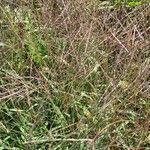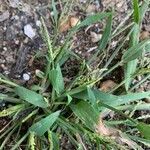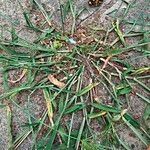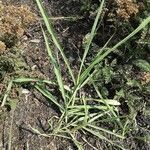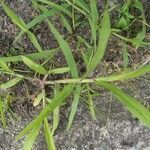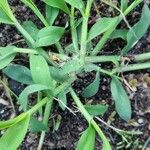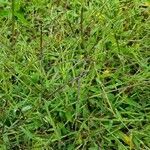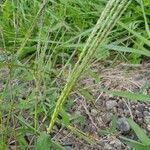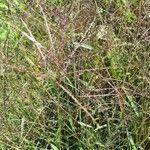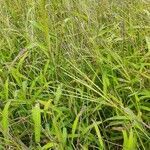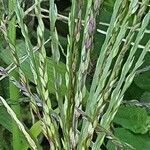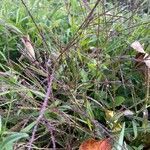Annual. Culms erect or decumbent at base, 10–80 cm tall, glabrous or nodes bearded. Leaf sheaths glabrous or sparsely papillose-pilose; leaf blades linear-lanceolate, 5–20 × 0.4–1.2 cm, glabrous or pilose, margins thickened, scabrous; ligule 1–3 mm. Inflorescence digitate or subdigitate, axis 1–2 cm; racemes 4–12, stiff, 5–18 cm; spikelets paired, overlapping by about 2/3 their length; rachis winged, midrib triquetrous, margins scabrous. Spikelets elliptic-lanceolate, 3–3.5 mm, acute; lower glume small, ca. 0.2 mm, triangular; upper glume lanceolate, 1/3–1/2 spikelet length, 3-veined, pubescent, subacute; lower lemma as long as spikelet, 7-veined, veins evenly spaced or a broader interspace flanking the midvein, midvein smooth, lateral veins setiform-scabrous especially toward the apex, appressed-pubescent on lateral intervein spaces and margins, rarely also setose; upper lemma greenish gray or light brown, lanceolate, as long as spikelet, apex acuminate. Anthers ca. 1 mm. Fl. and fr. Jun–Sep. 2n = 28, 36.
Annual; culms 20–60 cm. high or sometimes more, decumbent at the base, geniculately ascending.. Leaf-blades broadly linear to narrowly lanceolate, 3–30 cm. long, 3–17 mm. wide.. Inflorescence digitate or subdigitate (rarely with an axis up to 5 cm. long in robust specimens), of 2–16 racemes; racemes stiff, 3–20 cm. long, the spikelets binate and overlapping by about 2/3 of their length on a winged rhachis with triquetrous midrib.. Spikelets narrowly elliptic to ovate-elliptic, 2.3–3.5 mm. long, acute; lower glume a little ovate scale 0.2 mm. long; upper glume 1/3–1/2 as long as the spikelet, 3-nerved; lower lemma as long as the spikelet, 7-nerved, the nerves evenly spaced (or occasionally with a wide interspace flanking the midrib) and scaberulous, obscurely and appressedly pubescent, rarely with brownish glassy bristles, very rarely with a ciliate frill; fruit lanceolate, grey or light brown, as long as the lower lemma or almost so.
Tufted annual, 200-600 mm high; culms branched, decumbent and rooting from lower nodes, nodes dark, glabrous. Leaf blade 27-170 x 3-10 mm; ligule an unfringed membrane. Inflorescence digitate or subdigitate, of 3-12 racemes; rachis triquetrous, broadly winged, glabrous to scaberulous; pedicels triangular, scaberulous; spikelets abaxial, paired. Spikelets 2.3-3.5 mm long, acute, dorsiventrally compressed; lower glume a small ovate-triangular scale 0.2-0.3 mm long; upper glume shorter to as long as spikelet, 3-nerved, pubescent, hairs fine; internode absent. Florets 2; lower floret sterile, lemma lanceolate, equalling or shorter than spikelet, 7-nerved, scaberulous along nerves (may need a strong lens); upper floret bisexual, lemma ± as long as spikelet, pale yellow to pale brown, margins flat and covering most of palea. Flowering time Nov.-May.
Decumbent or geniculate-spreading annual; culms geniculate and commonly rooting at the lower nodes, ascending, 15 cm. to more than 1 m. long; sheaths shorter than the internodes, sparsely to rather densely papillose-hirsute; ligule membranaceous, truncate, 1-2 mm. long; blades 2-10 cm. long, or sometimes longer in robust specimens, 2-9 mm. wide, scabrous, sparsely to rather densely pilose or papillose-pilose with prominent white midnerve and margins; racemes 2-several, digitate or with a second whorl a short distance below, the rachis about 1 mm. wide, narrowly winged; spikelets 3 mm. long, the first glume small but plainly evident; second glume acuminate, about three-fourths as long as the fruit; sterile lemma slightly longer than the fruit, from nearly glabrous to prominently villous on the margins.
Tufted annual 200-600 mm high; culms branched, decumbent, rooting from lower nodes, nodes dark, glabrous. Leaf blade 27-170 x 3-10 mm. Inflorescence digitate or subdigitate, of 3-12 racemes 40-120 mm long; rachis triquetrous, broadly winged, glabrous to scaberulous; pedicel triangular, scaberulous; spikelets paired. Spikelet (1.8)2.3-3.5 mm long, acute; internode absent; lower glume a small ovate-triangular scale 0.2-0.3 mm long; upper glume shorter to nearly as long as spikelet, 3-nerved, adpressed hairy, hairs fine, acute; lower lemma equalling or just shorter than spikelet, acute, 7-nerved, scaberulous along nerves (may need a strong lens and easier to see near apex); upper lemma exposed, as long as spikelet, acute, pale yellow to pale brown; anthers 0.7-1.2 mm long.
Decumbent or prostrate, much branched, rooting at the nodes, usually 3–6 dm; sheaths and blades papillose-pilose, the blades 4–10 cm × 5–10 mm; racemes 3–6 in each of 1–3 whorls, 5–15 cm; rachis 1 mm wide, broadly winged, scabrous on the margins; pedicels triquetrous, scabrous; spikelets 2.4–3.2 mm; first glume minute, often deciduous, the second 0.8–1.8 mm, a third to three-fifths the length of the spikelet; sterile lemma usually scabrous on the 5 strong veins; fertile lemma grayish-brown; 2n=18–76, mostly 36. Native of Europe, now cosmop. and established as a weed of lawns, fields, gardens, and waste places throughout our range and w. to the Pacific, giving way southward to no. 5 [Digitaria ciliaris (Retz.) Koeler].
Spreading annual, up to 0.5 m tall, often rooting at nodes. Leaves linear; ligule an unfringed membrane. Inflorescence of 3-12 digitately or subdigitately arranged racemes, rhachis broadly winged. Spikelets 2.3-3.1 mm long, appressed hairy, hairs long and dense; upper glume shorter than spikelet; 2-flowered, lower sterile, awnless; nerves of lemma scabrid (often very difficult to see); upper lemma of `digitaria' type.
A millet grass. It is an annual grass. It can be 10-80 cm tall. It tends to lie along the ground and root at the nodes. The nodes and leaf sheaths are covered with fine hairs. The leaf blades are 5-20 cm long. The flower spike spreads out like fingers on a hand. The spikelets are usually in pairs. They are on short stalks of unequal length.
Annual, tufted, up to 0.6 m high. Leaf blades 27-170 mm long, 3-10 mm wide. Culms branched, decumbent and rooting from lower nodes. Spikelets 2.3-3.1 mm long, 1 mm wide. Racemes 3-12, digitate or subdigitate, 40-105 mm long; lower lemma equalling or shorter than spikelet, scaberulous along nerves, very rarely with a ciliate frill.
Annual; up to 0.6 m high; tufted. Culms branched; decumbent and rooting from lower nodes. Leaf blades 27-170 x 3-10 mm. Flowers: inflorescence digitate or subdigitate; racemes 3-12; 40-105 mm long; spikelets 2.3-3.1 x 1 mm; lower lemma equalling or shorter than spikelet; scaberulous along nerves; very rarely with a ciliate frill.
Leaf laminae 3–12 × 0.1–0.5 cm., linear, flat, scaberulous on both surfaces, with a few bulbous based bristles on the superior surface, near the base, scaberulous along the margin.
Inferior lemma as long as the spikelet, ovate-oblong, 7-nerved, nerves scabrous, especially the subcentral and submarginal nerves, central zone often broad, appressed hairy.
Superior lemma as long as to somewhat shorter than the spikelet, oblong-lanceolate, slightly acuminate, pale yellow to pale brown, sometimes purplish tinged.
Inflorescence composed of (2)4–8 racemes, (3)6–12 cm. long, erect, (2)3–4(5) in a inferior whorl, sometimes a second, superior whorl of 2–3 racemes.
Superior glume 1/3–2/3 of the spikelet, ovate to oblong triangular, 3-nerved, appressed hairy, hairs fine, smooth, acute.
Spreading annual to 50 cm. Leaves linear. Spikelets in 3-12 digitately arranged racemes, lemmas scabrid.
Rhachis triquetrous, broadly winged, up to 0.7 mm. wide, smooth to scaberulous with scabrous margins.
Culms 20–60 cm., decumbent or creeping at the base, glabrous, nodes dark and glabrous.
Pedicels 2-nate, 0.3–3 mm. long, triangular, scabrous, scarcely widened at the apex.
Inferior glume short, triangular, sometimes truncate or even slightly bifid.
A loosely caespitose or solitary growing annual.
Spikelets (1.8)2.1–2.8 mm. long, ovate-oblong.
Ligule 1–2 mm. long, truncate, erose.
Leaf sheaths smooth to scaberulous.
